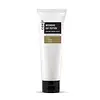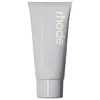What's inside
What's inside
 Key Ingredients
Key Ingredients

 Benefits
Benefits

 Concerns
Concerns

 Ingredients Side-by-side
Ingredients Side-by-side

Water
Skin ConditioningGlycerin
HumectantParaffinum Liquidum
EmollientButylene Glycol
HumectantDipropylene Glycol
HumectantCaprylic/Capric Triglyceride
MaskingSodium Hyaluronate
HumectantButylene Glycol Dicaprylate/Dicaprate
EmollientPolyglyceryl-3 Methylglucose Distearate
EmulsifyingNiacinamide
SmoothingGlyceryl Acrylate/Acrylic Acid Copolymer
HumectantPropylene Glycol
Humectant1,2-Hexanediol
Skin ConditioningCetearyl Alcohol
EmollientPolysorbate 60
EmulsifyingCyclomethicone
EmollientMacadamia Integrifolia Seed Oil
Skin ConditioningButyrospermum Parkii Butter
Skin ConditioningBetaine
HumectantPanax Ginseng Root Extract
EmollientAcanthopanax Senticosus Root Extract
Skin ConditioningPunica Granatum Fruit Extract
AntioxidantCarthamus Tinctorius Flower Extract
Skin ConditioningPanax Ginseng Callus Culture Extract
Skin ConditioningHydrolyzed Collagen
EmollientGanoderma Lucidum Extract
Skin ProtectingGrifola Frondosa Extract
Skin ConditioningPhellinus Linteus Extract
Skin ConditioningFomes Officinalis Extract
Skin ProtectingSarcodon Aspratus Extract
AntioxidantTrametes Versicolor Extract
Inonotus Obliquus Extract
Skin ConditioningAgaricus Blazei Extract
Skin ConditioningTricholoma Matsutake Extract
Skin ConditioningPropolis Extract
Skin ConditioningHydrogenated Lecithin
EmulsifyingSh-Oligopeptide-1
Skin ConditioningCopper Tripeptide-1
Skin ConditioningDimethicone
EmollientArachidyl Alcohol
EmollientBehenyl Alcohol
EmollientArachidyl Glucoside
EmulsifyingPolysorbate 20
EmulsifyingStearic Acid
CleansingPhenoxyethanol
PreservativeArginine
MaskingCarbomer
Emulsion StabilisingPanthenol
Skin ConditioningAllantoin
Skin ConditioningTocopheryl Acetate
AntioxidantAdenosine
Skin ConditioningDisodium EDTA
Xanthan Gum
EmulsifyingEthylhexylglycerin
Skin ConditioningParfum
MaskingWater, Glycerin, Paraffinum Liquidum, Butylene Glycol, Dipropylene Glycol, Caprylic/Capric Triglyceride, Sodium Hyaluronate, Butylene Glycol Dicaprylate/Dicaprate, Polyglyceryl-3 Methylglucose Distearate, Niacinamide, Glyceryl Acrylate/Acrylic Acid Copolymer, Propylene Glycol, 1,2-Hexanediol, Cetearyl Alcohol, Polysorbate 60, Cyclomethicone, Macadamia Integrifolia Seed Oil, Butyrospermum Parkii Butter, Betaine, Panax Ginseng Root Extract, Acanthopanax Senticosus Root Extract, Punica Granatum Fruit Extract, Carthamus Tinctorius Flower Extract, Panax Ginseng Callus Culture Extract, Hydrolyzed Collagen, Ganoderma Lucidum Extract, Grifola Frondosa Extract, Phellinus Linteus Extract, Fomes Officinalis Extract, Sarcodon Aspratus Extract, Trametes Versicolor Extract, Inonotus Obliquus Extract, Agaricus Blazei Extract, Tricholoma Matsutake Extract, Propolis Extract, Hydrogenated Lecithin, Sh-Oligopeptide-1, Copper Tripeptide-1, Dimethicone, Arachidyl Alcohol, Behenyl Alcohol, Arachidyl Glucoside, Polysorbate 20, Stearic Acid, Phenoxyethanol, Arginine, Carbomer, Panthenol, Allantoin, Tocopheryl Acetate, Adenosine, Disodium EDTA, Xanthan Gum, Ethylhexylglycerin, Parfum
Water
Skin ConditioningGlycerin
HumectantCaprylic/Capric Triglyceride
MaskingButyrospermum Parkii Butter
Skin ConditioningBehenyl Alcohol
EmollientXylitylglucoside
HumectantNiacinamide
SmoothingSqualane
EmollientSodium Acrylates Copolymer
Acetyl Tetrapeptide-2
Skin ConditioningPalmitoyl Heptapeptide-27
Skin ConditioningPalmitoyl Oligopeptide-78
Skin ConditioningPalmitoyl Octapeptide-24
Skin ConditioningPhenoxyethanol
PreservativeAnhydroxylitol
Humectant1,2-Hexanediol
Skin ConditioningHydroxyethyl Acrylate/Sodium Acryloyldimethyl Taurate Copolymer
Emulsion StabilisingXylitol
HumectantLecithin
EmollientEthylhexylglycerin
Skin ConditioningGlucose
HumectantBisabolol
MaskingSodium Hyaluronate
HumectantTeprenone
Skin ConditioningPolysorbate 60
EmulsifyingSorbitan Isostearate
EmulsifyingCaprylyl Glycol
EmollientEuterpe Oleracea Fruit Extract
Potassium Sorbate
PreservativeCitric Acid
BufferingSorbic Acid
PreservativeLactic Acid/Glycolic Acid Copolymer
Skin ConditioningTocopherol
AntioxidantPolyvinyl Alcohol
Sodium Hydroxide
BufferingWater, Glycerin, Caprylic/Capric Triglyceride, Butyrospermum Parkii Butter, Behenyl Alcohol, Xylitylglucoside, Niacinamide, Squalane, Sodium Acrylates Copolymer, Acetyl Tetrapeptide-2, Palmitoyl Heptapeptide-27, Palmitoyl Oligopeptide-78, Palmitoyl Octapeptide-24, Phenoxyethanol, Anhydroxylitol, 1,2-Hexanediol, Hydroxyethyl Acrylate/Sodium Acryloyldimethyl Taurate Copolymer, Xylitol, Lecithin, Ethylhexylglycerin, Glucose, Bisabolol, Sodium Hyaluronate, Teprenone, Polysorbate 60, Sorbitan Isostearate, Caprylyl Glycol, Euterpe Oleracea Fruit Extract, Potassium Sorbate, Citric Acid, Sorbic Acid, Lactic Acid/Glycolic Acid Copolymer, Tocopherol, Polyvinyl Alcohol, Sodium Hydroxide
 Reviews
Reviews

Ingredients Explained
These ingredients are found in both products.
Ingredients higher up in an ingredient list are typically present in a larger amount.
1,2-Hexanediol is a synthetic liquid and another multi-functional powerhouse.
It is a:
- Humectant, drawing moisture into the skin
- Emollient, helping to soften skin
- Solvent, dispersing and stabilizing formulas
- Preservative booster, enhancing the antimicrobial activity of other preservatives
Behenyl Alcohol is a type of fatty alcohol (these are different from the drying, solvent alcohols).
Fatty Alcohols have hydrating properties and are most often used as an emollient or to thicken a product. They are usually derived from natural fats and oils; behenyl alcohol is derived from the fats of vegetable oils.
Emollients help keep your skin soft and hydrated by creating a film that traps moisture in.
In 2000, Behenyl Alcohol was approved by the US as medicine to reduce the duration of cold sores.
Learn more about Behenyl AlcoholThis ingredient is also known as shea butter. It is an effective skin hydrator and emollient.
Emollients help soothe and soften your skin. It does this by creating a protective film on your skin. This barrier helps trap moisture and keeps your skin hydrated. Emollients may be effective at treating dry or itchy skin.
Shea butter is rich in antioxidants. Antioxidants help fight free-radicals, or molecules that may harm the body. It is also full of fatty acids including stearic acid and linoleic acid. These acids help replenish the skin and keep skin moisturized.
While Shea Butter has an SPF rating of about 3-4, it is not a sunscreen replacement.
Shea butter may not be fungal acne safe. We recommend speaking with a professional if you have any concerns.
Learn more about Butyrospermum Parkii ButterThis ingredient is an emollient, solvent, and texture enhancer. It is considered a skin-softener by helping the skin prevent moisture loss.
It helps thicken a product's formula and makes it easier to spread by dissolving clumping compounds.
Caprylic Triglyceride is made by combining glycerin with coconut oil, forming a clear liquid.
While there is an assumption Caprylic Triglyceride can clog pores due to it being derived from coconut oil, there is no research supporting this.
Learn more about Caprylic/Capric TriglycerideEthylhexylglycerin (we can't pronounce this either) is commonly used as a preservative and skin softener. It is derived from glyceryl.
You might see Ethylhexylglycerin often paired with other preservatives such as phenoxyethanol. Ethylhexylglycerin has been found to increase the effectiveness of these other preservatives.
Glycerin is already naturally found in your skin. It helps moisturize and protect your skin.
A study from 2016 found glycerin to be more effective as a humectant than AHAs and hyaluronic acid.
As a humectant, it helps the skin stay hydrated by pulling moisture to your skin. The low molecular weight of glycerin allows it to pull moisture into the deeper layers of your skin.
Hydrated skin improves your skin barrier; Your skin barrier helps protect against irritants and bacteria.
Glycerin has also been found to have antimicrobial and antiviral properties. Due to these properties, glycerin is often used in wound and burn treatments.
In cosmetics, glycerin is usually derived from plants such as soybean or palm. However, it can also be sourced from animals, such as tallow or animal fat.
This ingredient is organic, colorless, odorless, and non-toxic.
Glycerin is the name for this ingredient in American English. British English uses Glycerol/Glycerine.
Learn more about GlycerinNiacinamide is a multitasking form of vitamin B3 that strengthens the skin barrier, reduces pores and dark spots, regulates oil, and improves signs of aging.
And the best part? It's gentle and well-tolerated by most skin types, including sensitive and reactive skin.
You might have heard of "niacin flush", or the reddening of skin that causes itchiness. Niacinamide has not been found to cause this.
In very rare cases, some individuals may not be able to tolerate niacinamide at all or experience an allergic reaction to it.
If you are experiencing flaking, irritation, and dryness with this ingredient, be sure to double check all your products as this ingredient can be found in all categories of skincare.
When incorporating niacinamide into your routine, look out for concentration amounts. Typically, 5% niacinamide provides benefits such as fading dark spots. However, if you have sensitive skin, it is better to begin with a smaller concentration.
When you apply niacinamide to your skin, your body converts it into nicotinamide adenine dinucleotide (NAD). NAD is an essential coenzyme that is already found in your cells as "fuel" and powers countless biological processes.
In your skin, NAD helps repair cell damage, produce new healthy cells, support collagen production, strengthen the skin barrier, and fight environmental stressors (like UV and pollution).
Our natural NAD levels start to decline with age, leading to slower skin repair, visible aging, and a weaker skin barrier. By providing your skin niacinamide, you're recharging your skin's NAD levels. This leads to stronger, healthier, and younger looking skin.
Another name for vitamin B3 is nicotinamide. This vitamin is water-soluble and our bodies don't store it. We obtain Vitamin B3 from either food or skincare. Meat, fish, wheat, yeast, and leafy greens contain vitamin B3.
The type of niacinamide used in skincare is synthetically created.
Learn more about NiacinamidePhenoxyethanol is a preservative that has germicide, antimicrobial, and aromatic properties. Studies show that phenoxyethanol can prevent microbial growth. By itself, it has a scent that is similar to that of a rose.
It's often used in formulations along with Caprylyl Glycol to preserve the shelf life of products.
Polysorbate 60 is used to help stabilize products. It is a surfactant and emulsifier. These properties help keep ingredients together in a product. Surfactants help reduce surface tension between ingredients with different states, such as liquids and solids. Emulsifiers help prevent oils and waters from separating.
Polysorbate 60 is sorbitol-based and created from the ethoxylation of sorbitan. Ethoxylation is a chemical reaction used to add ethylene oxide. Sorbitan is a the dehydrated version of sorbitol, a sugar found in fruits.
In this case, the 60 comes from reacting 60 units of ethylene oxide with sorbitan.
Polysorbates are commonly used in medicine and foods.
Learn more about Polysorbate 60Sodium Hyaluronate is hyaluronic acid's salt form. It is commonly derived from the sodium salt of hyaluronic acid.
Like hyaluronic acid, it is great at holding water and acts as a humectant. This makes it a great skin hydrating ingredient.
Sodium Hyaluronate is naturally occurring in our bodies and is mostly found in eye fluid and joints.
These are some other common types of Hyaluronic Acid:
Learn more about Sodium HyaluronateWater. It's the most common cosmetic ingredient of all. You'll usually see it at the top of ingredient lists, meaning that it makes up the largest part of the product.
So why is it so popular? Water most often acts as a solvent - this means that it helps dissolve other ingredients into the formulation.
You'll also recognize water as that liquid we all need to stay alive. If you see this, drink a glass of water. Stay hydrated!
Learn more about Water